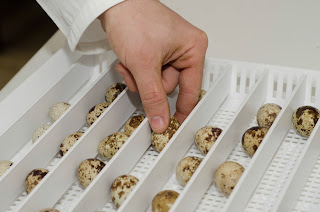Countryside Management Students
at Moulton College have recently seen the rewards of many weeks of hard work
and effort. The eight week old Japanese Quail which they have raised from eggs
are now fully grown and will soon start laying eggs of their own.
Back in February students took
delivery of a batch of Japanese Quail eggs which they then reared as part of
their game bird production unit. This unit gives them an opportunity to learn
how to rear game birds to supply shooting estates. Although these quail will
never be released on a shoot like pheasants or partridge they are capable of
producing fertile eggs all year round unlike British game birds. This gives the
Countryside Management students a perfect opportunity to carry out a rearing
project all the way from egg to adult bird.
Once the eggs had arrived the
students operated the Brinsea OvaEasy incubator to incubate the eggs for the
required 17 days. They kept records of fluctuations in temperature, humidity
and egg weight as well as checking the progress of incubation using a method
called candling. This method required the group to shine the light of a torch
through the egg shell to check for signs of development.
At 15 days the incubator’s
automatic egg turner was switched off to provide a stable platform for the
hatching chicks and within a couple of days students found the first chicks had
hatched. Over the next 24 hours the hatch continued until the chicks could be transferred
from the incubator to their permanent indoor enclosure where they would remain
for the first two weeks of their lives. During this time students learned how
to carry out health checks, mix medicated feed and maintain cleanliness and
biosecurity. After two weeks the chicks were transferred to an outside run
which the students had built which is supplied with electricity to power the
heat lamps to keep the birds warm. Students have continued to monitor the
progress of the birds most recently learning to sex them ready for sale.

















































